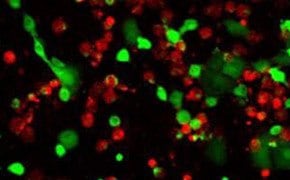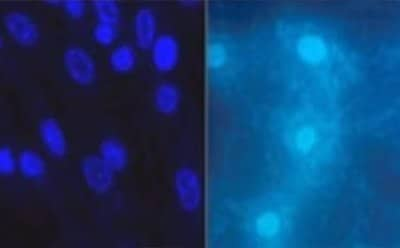Cell Health Analysis

Cell health analysis reagents, kits, and tools measure general and specific indicators of cell culture vigor. Viability assays may be used as a general measure of cell health, or to assess the effects of treatment along with cytotoxicity assays. Proliferation assays often use DNA synthesis and cell division as a measure of metabolic activity of cells as the result of conditions or treatments. Cytotoxicity kits can employ bioreduction readouts to assess metabolic activity.
Culture contamination is one of the most common barriers to efficient, reliable cell culture. Although some contaminants can be detected by conscientious microscopic inspection of cultures, contaminants like mycoplasma evade visual detection methods. Cultures should therefore instead be routinely screened using kits and reagents that reliably detect microbial contaminants. Reagents that minimize and eliminate contamination when it occurs are culture room essentials that augment sterile technique and good culture room practices.
Products
Cell Viability and Proliferation Assays
Assays for measuring cell proliferation and viability are used to monitor the response and health of cells in culture after treatment with various stimuli. The appropriate choice of an assay method depends on the number and type of cells to be assessed, as well as the expected outcome. Cell proliferation assays may monitor the number of cells over time, the number of cellular divisions, metabolic activity, or DNA synthesis. Cell counting using viability dyes such as trypan blue or calcein-AM can provide both the rate of proliferation as well as the percentage of viable cells. 5(6)-Carboxyfluorescein diacetate N-succinimidyl ester (CFSE) (21888, SCT110) is a popular choice for measuring the number of cellular divisions a population has undergone. Upon entering the cell, CFSE is cleaved by intracellular esterases to form the fluorescent compound, and the succinimidyl ester group covalently reacts with primary amines on intracellular proteins. On each division, the fluorescence intensity of each daughter cell is halved, enabling the simple detection of the number of cell divisions by flow cytometry.

Metabolism of MTT to a formazan salt by viable cells as shown in a 96-well plate
Our comprehensive tools and solutions for measuring cell viability and proliferation employ various methods, and include:
- DNA Synthesis Proliferation Assays
- Metabolic Proliferation Assays
- Luminescent Cell Viability Assays
- Fluorescent Dye Proliferation Assays
- Live/Dead/Total Cell Triple Staining for 3D Cultures
- Trypan Blue Dye Exclusion Viability Counting
Cytotoxicity Assays
Assays that measure metabolic activity are suitable for analyzing proliferation, viability, and cytotoxicity. The reduction of tetrazolium salts such as MTT and XTT to colored formazan compounds or the bioreduction of resazurin (R7017, TOX8) only occurs in metabolically active cells. Actively proliferating cells increase their metabolic activity, while distressed cells such as those exposed to toxins will demonstrate decreased activity.
Apoptosis Assays
Cell death is necessary for many normal physiological functions in the course of both development and homeostasis. The capacity for tumor cells to elude programmed cell death, also known as apoptosis, is a hallmark of most types of cancer. A wide variety of cellular proteins, including cell surface receptors, adaptors, proteases and mitochondrial components, regulate a fine balance between cell survival and death by apoptosis. Thoughtful assay selection can help to analyze not only the effects of cell culture conditions and treatments on cell health, but the mechanisms by which they affect cell health. We provide a complete range of assay products for early, mid and late stage apoptosis detection.
Cell Contamination Detection and Elimination
The maintenance of contamination-free cell cultures is fundamental to cell-based research. Among the most pervasive cell culture problems is contamination with mycoplasma, a genus of bacteria whose morphology is characterized by sub-micron size and the absence of a cell wall, making these bacteria difficult or impossible to detect by microscopy and resistant to many antibiotics. Although mycoplasma do not usually cause cell death, they are responsible for a variety of effects on cultured cells that includes dysregulated metabolism, reduced proliferation, and chromosomal aberrations. In short, mycoplasma contamination compromises the validity of affected cell lines for providing meaningful data for life science research.

Our tools for mycoplasma detection and elimination include:
- LookOut® Mycoplasma PCR Detection Kit and other PCR and qPCR kits for reliable, sensitive unmasking of mycoplasma in cell cultures
- Tryptose phosphate broth and other reagents for detection by mycoplasma culture
- DNA stains for detecting mycoplasma by fluorescent DNA staining method
- LookOut® Mycoplasma Erase spray and reagents for mycoplasma decontamination
Related Resources
- Cell Viability and Proliferation Assays
Cell based assays for cell proliferation (BrdU, MTT, WST1), cell viability and cytotoxicity experiments for applications in cancer, neuroscience and stem cell research.
- Cell Viability and Proliferation Assays
Cell based assays for cell proliferation (BrdU, MTT, WST1), cell viability and cytotoxicity experiments for applications in cancer, neuroscience and stem cell research.
- Apoptosis Assays
Cellular apoptosis assays to detect programmed cell death using Annexin V, Caspase and TUNEL DNA fragmentation assays.
- Mycoplasma Detection, Prevention, and Elimination in Cell Culture
Detect mycoplasma contamination in cell culture through the PCR, DNA stain, or culture tests. Discover mycoplasma prevention, elimination, and detection kits.
- Angiogenesis Assays
Cell based angiogenesis assays to analyze new blood vessel formation for applications of cancer research, tissue regeneration and vascular biology.
- Autophagy Assays
Cell based autophagy assays including live cell LC3 GFP/RFP lentiviral biosensors, kits for autophagy detection and autophagy activators and inhibitors.
- MTT Assay Protocol for Cell Viability and Proliferation
MTT assay protocol for measuring cell viability, proliferation and cytotoxicity. Instructions for MTT reagent preparation and examples of applications.
- Apoptosis Assays
Cellular apoptosis assays to detect programmed cell death using Annexin V, Caspase and TUNEL DNA fragmentation assays.
- Cell Viability and Proliferation Assays
Cell based assays for cell proliferation (BrdU, MTT, WST1), cell viability and cytotoxicity experiments for applications in cancer, neuroscience and stem cell research.
To continue reading please sign in or create an account.
Don't Have An Account?